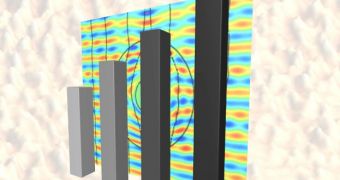Materials scientists from the Purdue University are currently at the forefront of research in this field, developing the building blocks that tomorrow's advanced optical technologies will use. They are creating materials from scratch, in ways that enable the innovations to fulfill certain functions.
For instance, one of the main directions for exploration is the development of plasmonic nanomaterials, that could be used to create invisibility cloaks, extremely fast microscopes and microprocessors, as well as solar panels with amazing conversion rates.
If their work succeeds, they could unlock nanophotonic (nanoscale photonic) device technology, that would enable to creation of highly-advanced optical apparatuses. In all fairness, not even the Purdue team is aware of all the potential implications of its work.
The metamaterial research project is being coordinated by Purdue assistant professor of electrical and computer engineering Alexandra Boltasseva, who is a leading expert in this field of science.
What her team is looking for are methods of creating materials with an index of refraction that is either negative or between one and zero. Refraction is a phenomenon that causes electromagnetic waves to bend as they pass through various materials, or from one material layer to another.
This is visible for example when placing a pencil behind a water glass. The pencil no longer appears straight, but distorted. The effect is caused by light passing through water, which has a high refraction index.
The field of study dealing with creating materials with a negative or very tiny refraction index is called transformation optics, and the Purdue research group is made of experts in optical physics.
Despite the progress made in the field over the past few years, experts still need to deal with two very important problems – excessive light absorption by the materials, and the proper index of refraction for a large variety of materials has yet to be accurately established.
In an article published in the January 21 issue of the esteemed journal Science, the team proposes a new approach to circumventing these issues, that revolves around eliminating silver and gold from these advanced materials.
According to Boltasseva and California Institute of Technology (Caltech) professor of applied physics and materials science Harry Atwater, the answer lies with adding metal impurities to semiconductors, in order to make them more metallic.
The other approach is to add non-metallic elements to metals, so as to make them less metallic. Aluminum oxides and titanium nitride are excellent choices for replacing silver and gold, and they are bound to play an important role in future optical technologies.
The new investigation was made possible through funding obtained from the US Army Research Office (ARO), experts at the Purdue University conclude.

 14 DAY TRIAL //
14 DAY TRIAL //